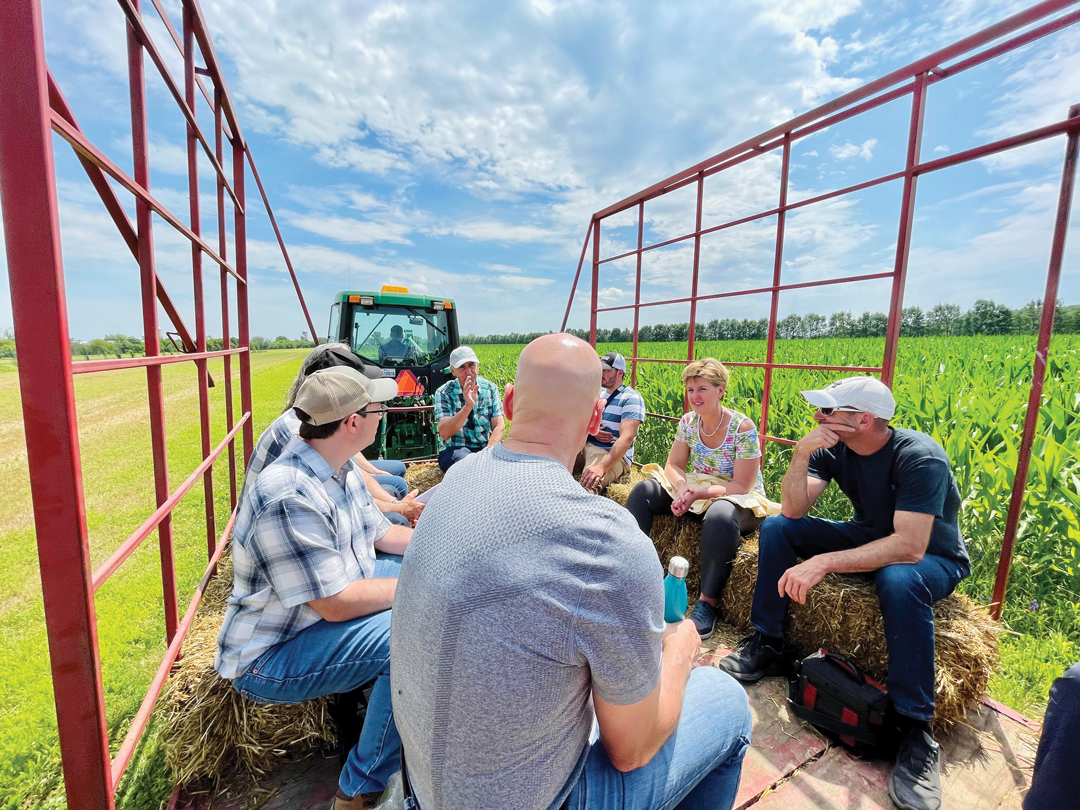LESS TALK, MORE WALK
BY TREVOR BACQUE • PHOTO COURTESY OF GOVERNMENT FO CANADA
Across Canada, the federal government continues its push of the ag industry towards greater sustainability to offset climate change.
Its latest effort to that end is dubbed Agricultural Climate Solutions Living Labs (ACS), a 10-year $185 million initiative that will see farm-level uptake of both old and new solutions as a way to reduce greenhouses gases, namely carbon dioxide, as well as increase the resiliency of Canada’s food system.
This new investment of $54 million will be dispersed between B.C., Alberta, Saskatchewan, New Brunswick, Nova Scotia and Newfoundland and Labrador. One project, worth $8.5 million and led by Alberta Beef Producers (ABP), will focus on improving beef, forage and crop systems to improve soil carbon sequestration and reduce GHGs. A second project, to be managed by the Alberta Conservation Association, will focus primarily on conservation to improve soil health, reduce costs of production, and sequester carbon in the soil using regenerative agriculture with $7.7 in funding. A third $6 million project, shared between Alberta and the B.C. Peace Region, will work toward similar ends, but is specific to its northern geography.
According to ABP’s beef production and extension lead Karin Schmid, agriculture is collectively under a lot of pressure when it comes to environmental management. “On the whole, agriculture has a great story to tell. A program like this can really help to inform what management practices can improve productivity and profitability for producers while also having that positive environmental impact,” she said.
The ABP-led project also has support from more than 10 additional organizations, including Alberta Barley, the Alberta Wheat Commission (AWC) and Canfax. Primary outcomes and best management practices the government hopes to develop include crop rotations and cropping systems, land use changes, grazing management, livestock feeding and nutrient management.
Schmid explained Living Labs are less about traditional research and more about adoption. To that end, it’s important to understand why farmers adopt certain practices and then properly communicate this to a broader agricultural audience.
“This knowledge also helps with policy development when it comes to identifying and potentially even providing appropriate incentives for producers to adopt certain practices,” she said. She also noted certain practices are great in theory, but a financial obstacle may prevent farmers from adopting them. Other times, the government may want to see action, but there’s no direct benefit to a farmer. “If we’re thinking about a producer implementing a practice on-farm that maybe doesn’t have a benefit to their operation, but the government really wants this to be implemented, what do they need to provide producers with in order to make that happen?” she said.
Schmid also hopes the Living Labs initiative can help answer the “million-dollar question” of what the true potential is to cut GHGs in Alberta. She noted modelling is great, but it’s simply modelling. Hard data is required to understand and measure a program’s effectiveness. She pointed out the Canadian beef industry pledged a 3.4 million tonne carbon reduction in emissions each year while also reducing overall emissions by 33 per cent by 2030. Simply put, Schmid said these figures are difficult to pin down.
“And that’s especially true when it comes to carbon sequestration,” she said. “Carbon sequestration is usually a slow and incremental process that’s also affected by environmental conditions. You need quite a bit of time to see measurable differences. And because the rate of gain is relatively small due to individual management practices, we need to be able to multiply that out over a large number of acres for those differences to really start to be apparent and significant.”
Schmid admitted there are promising technologies now available, or soon to be, that can reduce GHG emissions but more validation is required to gain greater uptake by farmers.
Sheri Strydhorst, a farmer and agronomist near Barrhead, helped Schmid work on the program application while working for the Barley and Wheat commissions. She said it made sense for the crop commissions to be part of the work with ABP because of the total acres served.
“We want to make sure representation is present in the Living Labs; to make really measurable differences in carbon sequestration, it needs to be done on the majority of the farmed acres in the province,” she said. “We’ve lost some of the synergies between the livestock and the crop production system, and this is a way we can keep that specialization and the benefits from that, but maybe look at new models of how we can integrate our systems together for those sustainable benefits.”
The project will ideally include 15 farmers each from the Lethbridge, Edmonton and Peace regions of Alberta. These participants will then hopefully influence their neighbours through conversations about what is happening at their farm or ranch.
“We were provided with maps [from AAFC] that indicate where there is the most potential to sequester carbon throughout the province,” she said. “Like anything, you start with the low-hanging fruit. So, in areas where there is perhaps lower soil organic matter, it’s easier to sequester carbon there than maybe in a soil where you already have higher organic matter. We really were focused on the areas of easy wins.”
For some areas of the province, certain practices, such as cover cropping just don’t make sense for everyone. However, Strydhorst pointed to the adoption of no-till farming as a primary example of a practice that benefitted farmers throughout the province. She hopes Livings Labs can produce another no-till style winner. “What is the next step to make further gains in increases in carbon sequestration?” she said. “Because it made economic and profitability sense on-farm, that’s what we’re really looking for, is the next step in that process that makes economic sense and profitability sense on-farm.”
Strydhorst is optimistic this program can be a way for farmers to take the bull by the horns and get out from constantly being on the receiving end of whatever government policy is released. It’s their chance to work new practices into their regular farm activities. This may include modifying a practice to suit their equipment or specific environment.
“This is that chance to have a say, and to make things work,” she said. “So, it is a win-win for our contribution as agriculture to sequestering carbon. Also because I know farmers have done this in the past and really are proud of that. They really feel jaded when they don’t get credit for it.”
To learn more, visit agriculture.canada.ca/en/agricultural-science-and-innovation/living-laboratories-initiative.







Comments